Beko DN 133000, DN 133000X, DN 133000S User manual

DN 133000
DN 133000X
DN 133000S
Refrigerator
Réfrigérateur
Frigorífico
Ψυγείο
Hűtőszekrény

DN 133000
DN 133000X
DN 133000S
Frigorífico
Frigorifero
Kühlschrank
Хладилник
Hladilnik

Please read this manual first!
Dear Customer,
We hope that your product, which has been produced in modern plants and checked under the most meticulous quality control procedures, will provide you an effective service.
For this, we recommend you to carefully read the entire manual of your product before using it and keep it at hand for future references.
This manual
•Will help you use your appliance in a fast and safe way.
•Read the manual before installing and operating your product.
•Follow the instructions, especially those for safety.
•Keep the manual in an easily accessible place as you may need it later.
•Besides, read also the other documents provided with your product.
Please note that this manual may be valid for other models as well.
Symbols and their descriptions
This instruction manual contains the following symbols:
C Important information or useful usage tips.
AWarning against dangerous conditions for life and property.
BWarning against electric voltage.
This product is supplied with the selective sorting symbol for waste electrical Recycling and electronic equipment (WEEE).
This means that this product must be handled pursuant to European Directive 2002/96/EC in order to be recycled or dismantled to minimise its impact on the environment. For further information, please contact your local or regional authorities.
Electronic products not included in the selective sorting process are potentially dangerous for the environment and human health due to the presence of hazardous substances.

CONTENTS
Your refrigerator |
3 |
|
2 |
Important Safety |
|
Warnings |
4 |
|
Intended use...................................... |
4 |
|
General safety.................................... |
4 |
|
Child safety........................................ |
6 |
|
HCA Warning..................................... |
6 |
|
Things to be done for energy saving... |
7 |
|
3 |
Installation |
8 |
Points to be considered when re- |
|
|
transporting your refrigerator.............. |
8 |
|
Before operating your refrigerator....... |
8 |
|
Disposing of the packaging................ |
9 |
|
Disposing of your old refrigerator........ |
9 |
|
Placing and Installation....................... |
9 |
|
Adjusting the legs............................. |
10 |
|
4 Preparation |
11 |
Reversing the doors......................... |
12 |
5 Using your refrigerator 13 |
|
Fridge compartment temperature |
|
setting button .................................. |
13 |
Making ice........................................ |
14 |
Freezer compartment temperature |
|
setting button .................................. |
14 |
Crisper humidity control sliders......... |
15 |
Using the rotary crisper (in some |
|
models)............................................ |
15 |
6 Maintenance and |
|
cleaning |
17 |
Protection of plastic surfaces .......... |
17 |
7 Recommended solutions |
|
for the problems |
18 |
2 EN

1 Your refrigerator
161
2
 11
11
3 



4
*5
6
4 

17 4
7
8
*9
10
12 13
*14 13 *15
*14 13
1- |
Freezer compartment shelf |
9- |
Crisper |
|
10- |
Adjustable legs |
|||
2- |
Ice container |
|||
11Freezer compartment door shelf |
||||
3- |
Fridge compartment temperature |
|||
12- |
Egg tray |
|||
setting button |
||||
13Fridge compartment door shelf |
||||
4- |
Adjustable body shelves |
|||
14Bottle shelter wire |
||||
5- |
Wine rack |
|||
15Rotary storage container |
||||
6- |
Illumination lens |
|||
16- |
Freezer compartment |
|||
7- |
Crisper cover |
|||
17- |
Fridge compartment |
|||
8- |
Crisper humidity control slider |
|||
* OPTIONAL |
||||
|
|
|||
Figures that take place in this instruction manual are schematic and may not correspond exactly with your product. If the subject parts are not included in the product you have purchased, then it is valid for other models.
3 EN

2 Important Safety Warnings
Please review the following information. If these are not followed, personal injury or material damage may occur. Otherwise, all warranty and reliability commitments will become invalid.
The usage life of the unit you purchased is 10 years. This is the period for keeping the spare parts required for the unit to operate as described.
Intended use
•This appliance is intended to be used in household and similar applications such as
–staff kitchen areas in shops, offices and other working environments;
–farm houses and by clients in hotels, motels and other residential type environments;
–bed and breakfast type environments;
–catering and similar non-retail
applications.
•It should not be used outdoors. It is not appropriate to use it outdoor even if the place is covered with a roof.
General safety
•When you want to dispose/scrap the product, we recommend you to consult the authorized service in
order to learn the required information and authorized bodies.
•Consult your authorized service for all your questions and problems related to the refrigerator. Do not intervene or let someone intervene to the refrigerator without notifying the authorized services.
•Do not eat cone ice cream and ice cubes immediately after you take them out of the freezer compartment!
(This may cause frostbite in your mouth.)
•Do not put bottled and canned liquid beverages in the freezer compartment. Otherwise, these may burst.
•Do not touch frozen food by hand; they may stick to your hand.
•Vapor and vaporized cleaning materials should never be used in cleaning and defrosting processes of your refrigerator. In such cases, the vapor might get in contact with the electrical parts and cause short circuit or electric shock.
•Never use the parts on your refrigerator such as the door as a means of support or step.
•Do not use electrical devices inside the refrigerator.
•Do not damage the cooling circuit, where the refrigerant is circulating, with drilling or cutting tools. The refrigerant that might blow out when the gas channels of the evaporator, pipe extensions or surface coatings are punctured may cause skin irritations and eye injuries.
•Do not cover or block the ventilation holes on your refrigerator with any material.
•Repairs of the electrical appliances must only be made by qualified persons. Repairs performed by incompetent persons may create a risk for the user.
•In case of any failure or during a maintenance or repair work,
disconnect your refrigerator’s mains supply by either turning off the relevant fuse or unplugging your appliance.
4 EN
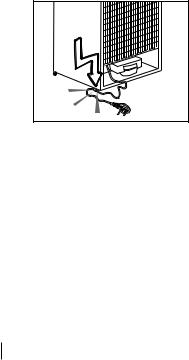
•Do not pull by the cable when pulling off the plug.
•Place the beverage with higher proofs tightly closed and vertically.
•Do not store explosive substances such as aerosol cans with a flammable propellant in this appliance.
•Do not use mechanical devices or other means to accelerate the
defrosting process, others than those recommended by the manufacturer.
•This appliance is not intended for use by persons (including children) with reduced physical, sensory or mental capabilities, or lack of experience and knowledge, unless they have been given supervision or instruction concerning use of the appliance by a person responsible for their safety.
•Do not operate a damaged refrigerator. Consult your service if you have any doubts.
•Electrical safety of your refrigerator shall be guaranteed only if the earth system in your house complies with standards.
•Exposing the product to rain, snow, sun and wind is dangerous with respect to electrical safety.
•Contact the authorized service when there is a power cable damage and etc. so that it will not create a danger for you.
•Never plug the refrigerator into the wall outlet during installation. Otherwise, risk of death or serious injury may arise.
•This refrigerator is designed solely for storing food. It should not be used for any other purposes.
•The label that describes the technical specification of the product is located on the inner left part of the
refrigerator. 5
•Do not hook up the refrigerator to electronic energy saving systems as it may damage the product.
•If the refrigerator has blue light do not look at the blue light through optical devices.
•If the power supply is disconnected in manually controlled refrigerators please wait for at least 5 minutes before reconnecting the power.
•This product manual should be passed to the next owner of the refrigerator if the owner changes.
•When moving the refrigerator make sure that you do not damage the power cord. In order to prevent fire the power cord should not be twisted. Heavy objects should not
be placed on the power cord. When the refrigerator is being plugged do not handle the power outlet with wet hands.
•Do not plug the refrigerator if the electric outlet is loose.
•Do not splash water directly on the outer or inner parts of the refrigerator due to safety.
•Do not spray inflammable materials such as propane gas etc near refrigerator due to the risk of fire and explosion.
•Do not place objects filled with water on top of the refrigerator as it may result in electric shock or fire.
EN

•Do not overload the refrigerator with excess food. The excess food may fall when the door is opened resulting in injuring you or damaging the refrigerator. Do not place objects on top of the refrigerator as the objects may fall when opening or closing the refrigerator door.
•Materials that require certain temperature conditions such as vaccine, temperature sensitive medicines, scientific materials etc should not be kept in refrigerator.
•If refrigerator will not be operated for an extended period of time it should be unplugged. A problem in electrical cable insulation may result in fire.
•The tip of the electric plug should be cleaned regularly otherwise it may cause fire.
•The refrigerator may move when the adjustable feet is not positioned firmly on the floor. Using the adjustable feet you can unsure that the refrigerator is positioned firmly on the floor.
•If the refrigerator has door handle do not pull the refrigerator via door handles when moving the product as it may disconnect the handle from the refrigerator.
•If you must operate your appliance adjacent to another refrigerator or freezer, the distance between the appliances must be at least 8 cm. Otherwise condensation may occur on the side walls facing each other.
•Water mains pressure must not be below 1 bar. Water mains pressure must not be above 8 bars.
•Use only drinkable potable water.
Child safety
•If the door has a lock, the key should be kept away from reach of children.
•Children should be supervised to ensure that they do not play with the appliance
HCA Warning
If your product is equipped with a cooling system that contains R600a:
This gas is flammable. Therefore, pay attention to not damaging the cooling system and piping during usage and transportation. In the event of damage, keep your product away from potential fire sources that can cause the product catch a fire and ventilate the room in which the unit is placed.
Ignore the warning if your product is equipped with a cooling system that contains R134a.
You can see the gas used in production of your product on the rating plate that is located on the left inner part of it.
Never dispose the product in fire.
6 EN

Things to be done for energy saving
•Do not leave the doors of your refrigerator open for a long time.
•Do not put hot food or drinks in your refrigerator.
•Do not overload your refrigerator so that the air circulation inside of it is not prevented.
•Do not install your refrigerator under direct sunlight or near heat emitting appliances such as ovens, dishwashers or radiators.
•Pay attention to keep your food in closed containers.
•Maximum amount of food can be put in your refrigerator’s freezer compartment when the freezer compartment shelf or drawer
is removed.Declared energy consumption value of your refrigerator was determined when the freezer compartment shelf or drawer was removed and under maximum amount of food load.There is no risk in using a shelf or drawer according to the shapes and sizes of the foods to be frozen.
7 EN

3 Installation
B Please remember that the manufacturer shall not be held liable if the information given in the
instruction manual is not observed.
Points to be considered when re-transporting your refrigerator
1.Your refrigerator must be emptied and cleaned prior to any transportation.
2.Shelves, accessories, crisper and etc. in your refrigerator must be fastened securely by adhesive tape against any jolt before repackaging.
3.Packaging must be tied with thick tapes and strong ropes and the rules of transportation printed on the package must be followed.
Please do not forget…
Every recycled material is an indispensable source for the nature and for our national resources.
If you wish to contribute to recycling the packaging materials, you can get further information from the environmental bodies or local authorities.
Before operating your refrigerator
Before starting to use your refrigerator check the following:
1.Is the interior of the refrigerator dry and can the air circulate freely in the rear of it?
2.You can install the 2 plastic wedges as illustrated in the figure. Plastic wedges will provide the required distance between your refrigerator and the wall in order to allow the air circulation. (The illustrated figure is
only an example and does not match
exactly with your product.) |
8 |
3.Clean the interior of the refrigerator as recommended in the “Maintenance and cleaning” section.
4.Plug the refrigerator into the wall outlet. When the fridge door is open the fridge compartment interior light will come on.
5.You will hear a noise as the compressor starts up. The liquid and gases sealed within the refrigeration system may also give rise to noise, even if the compressor is not running and this is quite normal.
6.Front edges of the refrigerator may feel warm. This is normal. These areas are designed to be warm to avoid condensation.
Electric connection
Connect your product to a grounded socket which is being protected by a fuse with the appropriate capacity.
Important:
•The connection must be in compliance with national regulations.
•The power cable plug must be easily accessible after installation.
•The specified voltage must be equal to your mains voltage.
•Extension cables and multiway plugs must not be used for connection.
EN

B A damaged power cable must be replaced by a qualified electrician.
B Product must not be operated before it is repaired! There is danger of
electric shock!
Disposing of the packaging
The packing materials may be dangerous for children. Keep the packing materials out of the reach of children or dispose them of by classifying them in accordance with the waste instructions. Do not
dispose them of along with the normal household waste.
The packing of your refrigerator is produced from recyclable materials.
Disposing of your old refrigerator
Dispose of your old machine without giving any harm to the environment.
•You may consult your authorized dealer or waste collection center of your municipality about the disposal of your refrigerator.
Before disposing of your refrigerator, cut out the electric plug and, if there are any locks on the door, make them inoperable in order to protect children against any danger.
Placing and Installation
A If the entrance door of the room where the refrigerator will be installed is not wide enough for the refrigerator to pass through, than call the authorized service to have them remove the doors of your refrigerator and pass it sideways through the door.
1.Install your refrigerator to a place that allows ease of use.
2.Keep your refrigerator away from heat sources, humid places and direct sunlight.
3.There must be appropriate air ventilation around your refrigerator in order to achieve an efficient operation.
If the refrigerator is to be placed in a recess in the wall, there must be at least 5 cm distance with the ceiling and at least 5 cm with the wall.
If the floor is covered with a carpet, your product must be elevated 2.5 cm from the floor.
4.Place your refrigerator on an even floor surface to prevent jolts.
5.Do not keep your refrigerator in ambient temperatures under 10°C.
9 EN
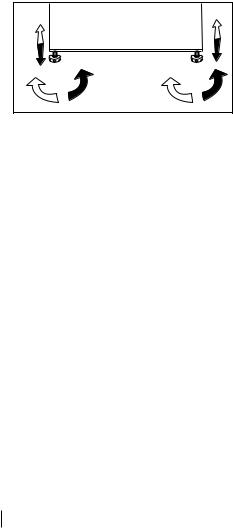
C This appliance is designed to operate at temperatures specified in the table below is equipped with Advanced Electronic Temperature Control System [AETCS] which
ensures that at the advised setting [4 - four on the knob] the frozen food in the freezer will not defrost even if the ambient temperature falls as low as -15 °C.
When first installed the product
MUST NOT be placed in low ambient temperatures because the freezer will not reduce to it’s standard operating temperature. Once it has reached its steady operating state it can be relocated.
So you may then install your appliance in a garage or an unheated room without having to worry about frozen food in the freezer being spoilt. However at low ambient temperatures mentioned above, fridge contents are likely to freeze, so check and consume food in the fridge accordingly. When the ambient temperature returns to normal, you may change the knob setting to suit your needs.
C If the ambient temperature is below 0°C, the food in the fridge compartment will freeze.So, we recommend you don’t use the fridge compartment in such low ambient conditions. You can continue using the freezer compartment as usual.
Adjusting the legs
If your refrigerator is unbalanced;
You can balance your refrigerator by turning the front legs of it as illustrated in the figure. The corner where the leg exists is lowered when you turn
in the direction of black arrow and raised when you turn in the opposite direction. Taking help from someone to slightly lift the refrigerator will facilitate this process.
10 EN

4 Preparation
CYour refrigerator should be installed at least 30 cm away from heat sources such as hobs, ovens, central heater and stoves and at least 5 cm away from electrical ovens and should not be located under direct sunlight.
CThe ambient temperature of the room where you install your
refrigerator should at least be 10°C. Operating your refrigerator under cooler conditions than this is not recommended with regard to its efficiency.
CPlease make sure that the interior of your refrigerator is cleaned thoroughly.
CIf two refrigerators are to be installed side by side, there should be at least 2 cm distance between them.
CWhen you operate your refrigerator for the first time, please observe the following instructions during the initial six hours.
-The door should not be opened frequently.
-It must be operated empty without any food in it.
-Do not unplug your refrigerator. If a power failure occurs out of your control, please see the warnings in the “Recommended solutions for the problems” section.
COriginal packaging and foam materials should be kept for future transportations or moving.
11 EN
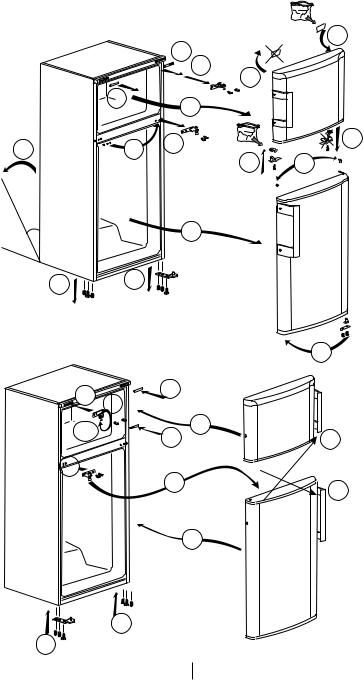
Reversing the doors
Proceed in numerical order .
|
|
|
|
10 |
|
|
|
4 |
|
|
|
|
5 |
|
|
|
|
10 |
|
|
4 |
|
2 |
|
|
|
|
|
|
|
|
|
1 |
11 |
7 |
|
6 |
|
|
|
|
|
||
|
|
|
12 |
13 |
45°
3
8 9
|
|
14 |
|
18 |
19 |
|
|
17 |
|
||
180° |
|
22 |
|
19 |
24 |
||
|
|||
23 |
|
|
|
|
21 |
24 |
|
|
|
||
|
|
20 |
16
15
12 EN
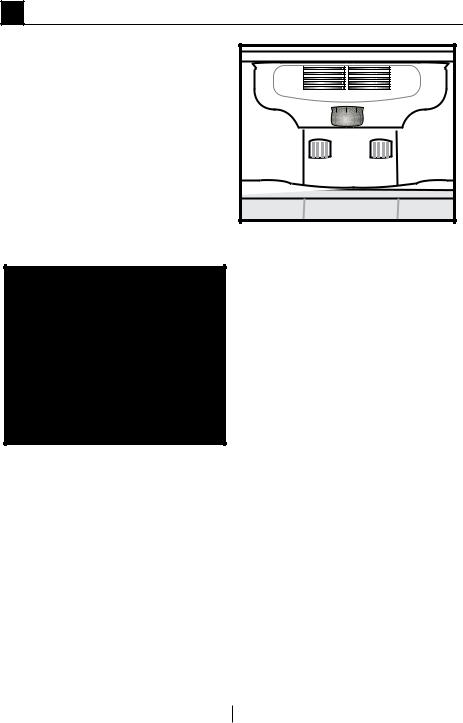
5 Using your refrigerator
Fridge compartment temperature setting button
Temperature button allows you to make the general temperature setting of your refrigerator.
Temperature button of the refrigerator controls both the temperature
of the freezer compartment and the amount of the air send to the fridge compartment and thus, the temperature of the fridge compartment.
At regular room temperatures:
Set the temperature button to a position between “2 and 3” to store your food.
5 |
4 |
3 |
At high room temperatures:
Temperature button must be set to a cooler position if the food is going to be frozen or large amounts of food will be loaded.
If the food in the fridge compartment
cools too much or freezes, temperature button must be set to position “1”.
If the fridge compartment is colder then the required 24 hours after the initial startup, open the lower door and turn the fridge compartment temperature setting button towards to the position “1” and if it is warmer then the required, slightly turn it towards to the position “5”.
13 EN
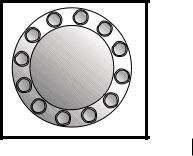
Freezer compartment temperature setting button
Freezer compartment setting button can be set to a position between
Normal and Quick Freezing.
•In Normal position, the amount of the air sent to the fridge compartment reaches to maximum.
•In Quick Freezing position, the amount of the air sent to the freezer compartment reaches to maximum. And the amount of the air sent to the fridge compartment decreases to minimum. In this case, the temperature of the fridge compartment will increase. This is normal.
•If you do not need more cooling in either of the compartments, leave the setting button in Normal position.
•In cases where the room temperature is high (25 °C and above), it is suggested to set the freezer compartment setting button to a position near the Normal.
•In low room temperatures, it is suggested to set the freezer
compartment setting button to a position between the Normal and Quick Freezing.
Making ice
Fill the ice container with water and place it into its seat. Your ice will be ready approximately in two hours.
You can easily remove your ice by slightly twisting the ice container.
14 |
EN |
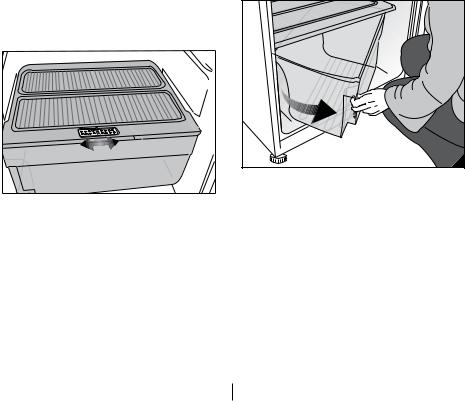
Crisper humidity control sliders
Using the crisper humidity control sliders
Crisper of your refrigerator is designed specially to keep your vegetables fresh without loosing their humidity. Cold air circulates basically around the crisper and the amount of the cold air passing through the crisper is controlled by the sliders on the front side of the crisper cover.
You can adjust the humidity control sliders to a suitable position according to the humidity and cooling condition of your food in the crisper.
If you want your food in the crisper to cool more, open the holes of the humidity control sliders and if you want them to cool less and keep their humidity for a longer time, close the holes.
Using the rotary crisper (in some models)
The crisper of your refrigerator which opens with a rotating movement is designed specially to provide ease of usage and allow you to store more vegetables and fruits (large volume) you buy during large shopping.
When you grab and pull the handle on the lower left hand side of the crisper, it will rotate from left to right and open easily. The separator in the crisper will allow you to separate the vegetables and fruits according to their types and prevent them from crushing.
15 EN

Rotary storage container
Sliding body shelf can be moved to left or right in order to allow you place long bottles, jars or boxes to a lower shelf (Fig. 1)
You can reach the food that you have placed into the shelf by grabbing and turning it from its right edge (Fig.2).
When you want to load or remove it to clean, turn it by 90 degrees, raise it up and pull towards yourself (Fig. 3-4).
1 |
2 |
3 |
4 |
16 EN

6 Maintenance and cleaning
ANever use gasoline, benzene or similar substances for cleaning purposes.
BWe recommend that you unplug the appliance before cleaning.
CNever use any sharp abrasive instrument, soap, household cleaner, detergent and wax polish for cleaning.
CUse lukewarm water to clean the cabinet of your refrigerator and wipe it dry.
CUse a damp cloth wrung out in a solution of one teaspoon of
bicarbonate of soda to one pint of water to clean the interior and wipe it dry.
BMake sure that no water enters the lamp housing and other electrical items.
BIf your refrigerator is not going to be used for a long period of time, unplug the power cable, remove all food, clean it and leave the door ajar.
CCheck door seals regularly to ensure they are clean and free from food particles.
CTo remove door racks, remove all the contents and then simply push the door rack upwards from the base.
Protection of plastic surfaces
CDo not put the liquid oils or oil-cooked meals in your refrigerator in unsealed containers as they damage the plastic surfaces of your refrigerator. In case of spilling or smearing oil on the plastic surfaces, clean and rinse the relevant part of the surface at once with warm water.
17 EN

7 Recommended solutions for the problems
Please review this list before calling the service. It might save you time and money. This list includes frequent complaints that are not arising from defective workmanship or material usage. Some of the features described here may not exist in your product.
The refrigerator does not operate
•Is the refrigerator properly plugged in? Insert the plug to the wall socket.
•Is the fuse of the socket which your refrigerator is connected to or the main fuse blown out? Check the fuse.
Condensation on the side wall of the fridge compartment. (MULTI ZONE, COOL CONTROL ve FLEXI ZONE)
•Very cold ambient conditions. Frequent opening and closing of the door. Highly humid ambient conditions. Storage of food containing liquid in open containers. Leaving the door ajar.
•Switching the thermostat to a colder degree.
•Decreasing the time the door left open or using it less frequently.
•Covering the food stored in open containers with a suitable material.
•Wipe the condensation using a dry cloth and check if it persists.
Compressor is not running
•Protective thermic of the compressor will blow out during sudden power failures or plug-out plug-ins as the refrigerant pressure in the cooling system of the refrigerator has not been balanced yet.
•Your refrigerator will start running approximately after 6 minutes. Please call the service if your refrigerator does not startup at the end of this period.
•The fridge is in defrost cycle. This is normal for a full-automatically defrosting refrigerator. Defrosting cycle occurs periodically.
•Your refrigerator is not plugged into the socket. Make sure that he plug is inserted tightly to the wall socket.
•Are the temperature adjustments correctly made? There is a power failure. Call your electricity supplier.
The fridge is running frequently or for a long time.
18 EN

•Your new refrigerator may be wider than the previous one. This is quite normal.
Large refrigerators operate for a longer period of time.
•The ambient room temperature may be high.This is quite normal.
•The refrigerator might have been plugged in recently or might have been loaded with food. Cooling down of the refrigerator completely may last for a couple of hours longer.
•Large amounts of hot food might have been put in the refrigerator recently. Hot food causes longer running of the refrigerator until they reach the safe storage temperature.
•Doors might have been opened frequently or left ajar for a long time. The warm air that has entered into the refrigerator causes the refrigerator to run for longer periods. Open the doors less frequently.
•Freezer or fridge compartment door might have been left ajar. Check if the doors are tightly closed.
•The refrigerator is adjusted to a very low temperature. Adjust the refrigerator temperature to a warmer degree and wait until the temperature is achieved.
•Door seal of the fridge or freezer may be soiled, worn out, broken or not properly seated. Clean or replace the seal. Damaged/broken seal causes the refrigerator to run for a longer period of time in order to maintain the current temperature.
Freezer temperature is very low while the fridge temperature is sufficient.
•The freezer temperature is adjusted to a very low temperature. Adjust the freezer temperature to a warmer degree and check.
Fridge temperature is very low while the freezer temperature is sufficient.
•The fridge temperature is adjusted to a very low temperature. Adjust the fridge temperature to a warmer degree and check.
Food kept in the fridge compartment drawers are freezing.
• The fridge temperature is adjusted to a very low temperature. Adjust the fridge temperature to a warmer degree and check.
Temperature in the fridge or freezer is very high.
19 EN

•The fridge temperature is adjusted to a very high degree. Fridge adjustment has an effect on the temperature of the freezer. Change the temperature of the fridge or freezer until the fridge or freezer temperature reaches to a sufficient level.
•The door might be left ajar. Close the door completely.
•Large amounts of hot food might have been put in the refrigerator recently. Wait until the fridge or freezer reaches the desired temperature.
•Refrigerator might have been plugged in recently. Cooling down of the refrigerator completely takes time because of the size.
Noise similar to the sound of seconds heard from an analog clock is coming from the refrigerator.
•This noise is coming from the solenoid valve of the refrigerator. Solenoid valve functions for the purpose of ensuring coolant passage through the compartment which can be adjusted to cooling or freezing temperatures, and performing cooling functions. This is normal and is not fault cause.
The operation noise increases when the refrigerator is running.
•The operating performance characteristics o f the refrigerator may change according to the changes in the ambient temperature. It is normal and not a fault.
Vibrations or noise.
•The floor is not even or it is weak. The refrigerator rocks when moved slowly. Make sure that the floor is level, strong and capable to carry the refrigerator.
•The noise may be caused by the items put onto the refrigerator. Such items should be removed from the top of the refrigerator.
There are noises like liquid spilling or spraying.
•Liquid and gas flows happen in accordance with the operating principles of your refrigerator. It is normal and not a fault.
There is a noise like wind blowing.
•Air activators (fans) are used in order to allow the refrigerator to cool efficiently. It is normal and not a fault.
Condensation on the inner walls of refrigerator.
•Hot and humid weather increases icing and condensation. It is normal and not a fault.
•The doors are ajar. Make sure that the doors are closed completely.
•Doors might have been opened very frequently or they might have been left open for along time. Open the door less frequently.
Humidity occurs on the outside of the refrigerator or between the doors.
•The weather may be humid. This is quite normal in humid weather. When the humidity is less, condensation will disappear.
20 EN

Bad odor inside the refrigerator.
•Inside of the refrigerator must be cleaned. Clean the inside of the refrigerator with a sponge, warm water or carbonated water.
•Some containers or packaging materials might be causing the smell. Use a different container or different brand packaging material.
The door(s) is (are) not closing.
•Food packages may prevent the door’s closing. Replace the packages that are obstructing the door.
•The refrigerator is probably not completely vertical on the floor and it might be rocking when slightly moved. Adjust the elevation screws.
•The floor is not level or strong. Make sure that the floor is level and capable to carry the refrigerator.
Crispers are stuck.
• The food might be touching the ceiling of the drawer. Rearrange food in the drawer.
21 EN

Veuillez d’abord lire la notice d’utilisation !
Chère cliente, cher client,
Nous espérons que votre produit, qui a été fabriqué dans des usines modernes et vérifié au terme des procédures de contrôle de qualité les plus méticuleuses, vous aidera efficacement.
Pour cette raison, nous vous conseillons de lire attentivement tout le manuel d’utilisation de votre produit avant de vous en servir, et de le conserver ensuite pour une utilisation ultérieure.
Le présent manuel
•vous aidera à utiliser votre produit avec rapidité et sécurité.
•Lisez le manuel avant d’installer et de faire fonctionner votre produit.
•Respectez les instructions, notamment celles relatives à la sécurité.
•Conservez ce manuel dans un endroit facilement accessible car vous pouvez en avoir besoin ultérieurement.
•En plus, lisez également les autres documents fournis avec votre produit. Veuillez noter que ce manuel peut également être valide pour d’autres modèles.
Symboles et descriptions
Vous retrouverez les symboles suivants dans le présent manuel :
CInformations importantes ou astuces.
AAvertissement relatif aux conditions dangereuses pour la vie et la propriété. BAvertissement relatif à la tension électrique.

Table des matières
1 Votre réfrigérateur |
3 |
2Précautions de sécurité |
|
importantes |
4 |
Utilisation prévue................................ |
4 |
Sécurité générale............................... |
4 |
Sécurité enfants................................. |
7 |
Avertissement HCA............................ |
7 |
Mesures d’économie d’énergie.......... |
7 |
3 Installation |
8 |
Points à prendre en compte lorsque |
|
vous transportez à nouveau votre |
|
produit............................................... |
8 |
Avant de faire fonctionner votre |
|
réfrigérateur........................................ |
8 |
Branchement électrique..................... |
9 |
Mise au rebut de l’emballage.............. |
9 |
Mise au rebut de votre ancien |
|
réfrigérateur........................................ |
9 |
Réglage des pieds........................... |
10 |
4 |
Préparation |
11 |
Réversibilité des portes.................... |
12 |
|
5 |
Utilisation de votre |
|
réfrigérateur |
13 |
|
Bouton de réglage du thermostat du |
||
compartiment réfrigérateur .............. |
13 |
|
Fabrication de glaçons..................... |
14 |
|
Bouton de réglage du thermostat du |
||
compartiment de congélation .......... |
14 |
|
Bac à légumes: utilisation des curseurs |
||
de réglage de l’humidité (dans certains |
||
modèles).......................................... |
15 |
|
Utilisation du bac à légumes rotatif |
|
|
(dans certains modèles).................... |
15 |
|
Récipient de conservation rotatif...... |
16 |
|
6 Entretien et nettoyage |
17 |
|
Protection des surfaces en |
|
|
plastique. ........................................ |
17 |
|
7 Solutions recommandées |
||
aux problèmes |
18 |
|
2 FR

1 Votre réfrigérateur
161
2
 11
11
3 



4
*5
6
4 

17 4
12 13
*14 13 *15
*14 13
CLes illustrations présentées dans cette notice d’utilisation sont schématiques et peuvent ne pas correspondre exactement à votre produit. Si des pièces présentées ne sont pas comprises dans le produit que vous avez acheté, elles sont valables pour d’autres modèles.
3 FR

2 Précautions de sécurité importantes
Veuillez examiner les informations suivantes: Si elles ne sont pas respectées, des blessures personnelles ou un dommage matériel peut survenir. Sinon, tout engagement lié à la garantie et à la fiabilité du produit devient invalide.
La durée de vie du produit que vous avez acheté est de 10 ans. Il s’agit ici de la période au cours de laquelle vous devez conserver les pièces de rechange nécessaires à son fonctionnement.
Utilisation prévue
•Cet appareil est concçu pour un usage domestique et des utilisations similaires comme
–les cuisines du personnel dans les boutiques, les bureaux et autres environnements de travail;
–les fermes et pour une utilisation par les clients dans les hôtels, motels et autres types d'environnment résidentiel;
–les environnements de type bed and breakfast
–le catering et les usages similaires non destinés à la vente
•Il ne doit en conséquence pas être utilisé à l’extérieur. Il n’est pas approprié à un usage en extérieurs, même si l’endroit est abrité par un auvent.
Sécurité générale
•Avant de vous débarrasser de votre appareil, veuillez consulter les autorités locales ou votre revendeur pour connaître le mode opératoire et les organismes agréés de collecte.
•Consultez le service après-vente agréé concernant toutes questions
ou problèmes relatifs au réfrigérateur. N’intervenez pas ou ne laissez personne intervenir sur le réfrigérateur sans le communiquer au service après-vente agréé.
•Ne mangez pas de cônes de crème glacée ou des glaçons immédiatement après les avoir sortis du compartiment de congélation. (Cela pourrait provoquer des gelures dans votre bouche).
•Ne placez pas de boissons en bouteilles ou en cannettes dans le congélateur. Cela peut entraîner leur
éclatement.
•Ne touchez pas des produits congelés avec les mains, ils pourraient se coller à celles-ci.
•La vapeur et des matériaux de nettoyage pulvérisés ne doivent jamais être utilisés pour les processus de nettoyage ou de dégivrage de votre réfrigérateur. La vapeur pourrait pénétrer dans les pièces électriques et provoquer des courts-circuits ou des électrocutions.
•Ne jamais utiliser les pièces de votre réfrigérateur telles que la porte, comme un support ou une marche.
•N’utilisez pas d’appareils électriques à l’intérieur du réfrigérateur.
•N’endommagez pas le circuit de refroidissement où circule le liquide réfrigérant avec des outils de forage ou coupants. Le liquide réfrigérant qui pourrait s’échapper si les canalisations de gaz de
l’évaporateur, les rallonges de tuyau ou les revêtements de surface
étaient percés, peut irriter la peau et provoquer des blessures aux yeux.
4 FR

•Ne pas couvrir ou obstruer les orifices de ventilation du réfrigérateur.
•Les réparations de l'appareillage électrique doivent être réalisées par des techniciens qualifiés.
Les réparations réalisées par des personnes ne présentant pas les compétences requises peuvent présenter un risque pour l’utilisateur.
•En cas de dysfonctionnement ou lors d'opérations d’entretien ou de réparation, débranchez l’alimentation électrique du réfrigérateur soit en désactivant le fusible correspondant, soit en débranchant l’appareil.
•Ne tirez pas sur le câble lorsque vous débranchez la prise.
•Placez les boissons alcoolisées verticalement, dans des récipients convenablement fermés.
•Ne conservez pas de substances explosives comme des aérosols avec un liquide inflammable dans cet appareil.
•N’utilisez pas d'outils mécaniques ou autres dispositifs pour accélérer le processus de décongélation autres que ceux qui sont recommandés par le fabricant.
•L’utilisation de cet appareil est interdite aux personnes (enfants compris) souffrant de déficience physique, sensorielle, mentale, ou justifiant d’un manque d’expérience à moins d’avoir obtenu une autorisation auprès des personnes responsables de leur sécurité.
•Ne faites pas fonctionner un réfrigérateur endommagé. Consultez le service après-vente en cas de doutes.
•La sécurité électrique du réfrigérateur n’est assurée que si le système de
mise à la terre de votre domicile est conforme aux normes en vigueur.
•L’exposition du produit à la pluie, la neige, au soleil ou au vent présente des risques concernant la sécurité électrique.
•Contactez le service après-vente agrée lorsque le câble d'alimentation est endommagé afin d’éviter tout danger.
•Ne branchez jamais le réfrigérateur à la prise murale au cours de l’installation. Vous vous exposeriez à un risque de mort ou à de blessures graves.
•Ce réfrigérateur a été fabriqué uniquement dans le but de conserver les denrées. Par conséquent, il ne doit pas être utilisé à d'autres fins.
•L'étiquette qui décrit les spécifications techniques du produit se trouve
sur la partie intérieure gauche du réfrigérateur.
•Évitez d'accrocher le réfrigérateur aux systèmes d'économie d'énergie
électronique car ils peuvent endommager le produit.
•Si le réfrigérateur est éclairé par une lumière bleue, évitez de regarder cette lumière bleue à travers des appareils optiques.
•Si l'alimentation électrique est coupée dans un réfrigérateur à commande manuelle, veuillez patienter pendant au moins 5 minutes avant de rétablir la connexion électrique.
•Si le propriétaire du réfrigérateur venait à changer, n'oubliez pas de remettre le présent manuel
d'utilisation au nouveau bénéficiaire.
•Veillez à ne pas endommager le câble d'alimentation pendant le transport du réfrigérateur. Afin d'éviter tout risque d'incendie, prenez garde de
5 FR
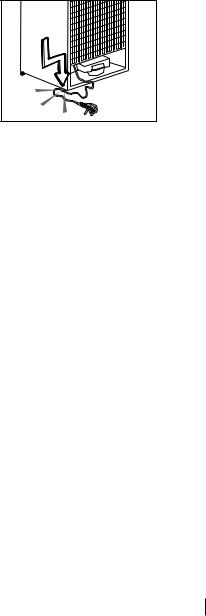
ne pas tordre le câble d'alimentation. Des objets lourds ne doivent pas être posés sur le câble d'alimentation.
Pendant le branchement du réfrigérateur, évitez de tenir la prise de courant avec des mains mouillées.
•Évitez de brancher le réfrigérateur lorsque la prise de courant électrique a lâché.
•Pour des raisons d'ordre sécuritaire, évitez tout contact direct de l'eau avec les parties externes et internes du réfrigérateur.
•En raison des risques d'incendie et d'explosion, évitez de vaporiser des matières inflammables comme le gaz propane à proximité du réfrigérateur.
•Pour éviter tout risque de choc électrique ou d'incendie, évitez de mettre des objets remplis d'eau audessus du réfrigérateur.
•Évitez de surcharger le réfrigérateur avec une quantité excessive d'aliments. Le trop-plein d'aliments peut tomber à l'ouverture de la porte, ce qui peut vous blesser ou endommager le réfrigérateur. Évitez de mettre des objets au-dessus du réfrigérateur dans la mesure où ceux-ci peuvent tomber pendant
l'ouverture ou la fermeture de la porte du réfrigérateur.
•Les objets nécessitant certaines conditions de conservation comme le vaccin, les médicaments sensibles
à la température, les matériels scientifiques, etc., ne doivent pas être conservés dans le réfrigérateur.
•Débranchez le réfrigérateur si vous n'allez pas vous en servir au cours d'une période prolongée.
Un problème survenu au niveau de l'isolation du câble électrique peut donner lieu à un incendie.
•Le bout de la fiche électrique doit être nettoyée régulièrement. Dans le cas contraire, il peut provoquer un incendie.
•Le réfrigérateur peut bouger lorsque les pieds réglables ne sont pas positionnés fermement sur le sol.
En ajustant les pieds réglables, vous pouvez savoir lorsque le réfrigérateur est positionné fermement sur le sol.
•Si la porte du réfrigérateur est dotée d'une poignée, évitez de tenir cette poignée pendant le transport de l'appareil car celle-ci est susceptible de se détacher du réfrigérateur.
•Si vous êtes tenu de faire fonctionner votre appareil tout près d'un autre réfrigérateur ou d'un congélateur, veuillez prévoir au moins 8 cm d'écart entre les deux appareils. Dans le cas contraire, il peut y avoir condensation au niveau des parois internes situées les unes en face des autres.
•La pression de l'eau ne doit pas être en-dessous d' 1 bar. La pression de l'eau ne doit pas être au-dessus de 8 bars.
•Utilisez uniquement de l’eau potable.
6 FR

Sécurité enfants
•Si la porte a un verrouillage, la clé doit rester hors de portée des enfants.
•Les enfants doivent être encadrés afin d’éviter tout jeu avec l’appareil.
Avertissement HCA
Si votre appareil est équipé d’un système de refroidissement contenant R600a :
Ce gaz est inflammable. Par conséquent, veuillez prendre garde à ne pas endommager le système de refroidissement et les tuyauteries lors de son utilisation ou de son transport.
En cas de dommages, éloignez votre produit de toute source potentielle de flammes susceptible de provoquer l’incendie de l’appareil. De même, placez le produit dans une pièce aérée.
Ignorez l’avertissement si votre appareil est équipé d’un système de refroidissement contenant R134a.
Vous pouvez voir le gaz été utilisé dans la fabrication de votre appareil sur la plaque signalétique qui se trouve dans la partie intérieure gauche du produit.
Ne jamais jeter le produit au feu.
Mesures d’économie d’énergie
•Ne laissez pas les portes du réfrigérateur ouvertes pendant une durée prolongée.
•N’introduisez pas de denrées ou de boissons chaudes dans le réfrigérateur.
•Ne surchargez pas le réfrigérateur pour ne pas obstruer pas la circulation d'air à l’intérieur.
•N’installez pas le réfrigérateur à la lumière directe du soleil ou près d’appareil émettant de la chaleur tels qu’un four, un lave-vaisselle ou un radiateur.
•Veillez à conserver vos denrées dans des récipients fermés.
•Une quantité maximale de nourriture peut être mise dans le compartiment congélateur de votre réfrigérateur quand l'étagère ou le tiroir du compartement est enlevé. Le niveau de consommation d'énergie affiché pour votre réfrigérateur a été déterminé quand l'étagère ou le tiroir du compartiment congélateur a été enlevé et que la quantité de nourriture
était maximale. L'utilisation d'une étagère ou d'un tiroir en fonction de la taille et de la nature de la nature à congeler ne comporte aucun risque.
7 FR
